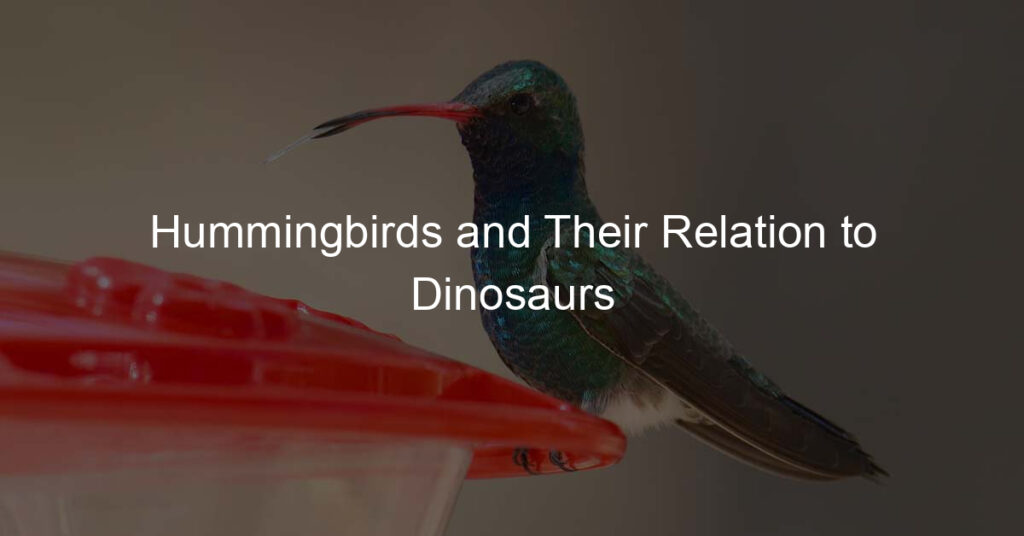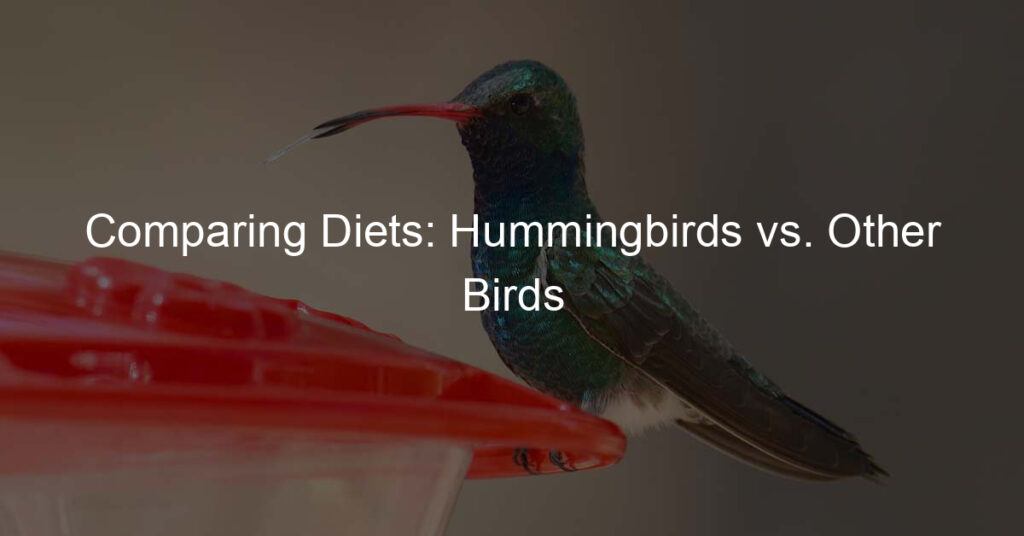This blog post explores the fascinating relationship between hummingbirds and dinosaurs, delving into the evolutionary links that bind these two seemingly disparate groups of creatures together. We will thread through the path of their shared ancestry, characteristics, and physiology, providing a comprehensive view of how these tiny, vibrant birds are direct descendants of the mighty dinosaurs.
How are Hummingbirds and Dinosaurs Connected?: An Overview
Hummingbirds and dinosaurs may seem like an unlikely pair at first glance, but upon closer examination, their connection becomes evident. These tiny, vibrant birds share a remarkable evolutionary link to the ancient reptiles that once roamed the Earth. While hummingbirds belong to the class Aves and dinosaurs to the class Reptilia, they both share a common ancestor that lived millions of years ago. This ancestral connection can be traced back to the time when dinosaurs still walked the Earth, during the Mesozoic Era.
During this era, a group of dinosaurs known as theropods began to evolve feathers, which eventually led to the emergence of birds. These feathered dinosaurs were the precursors to modern birds, and it is believed that hummingbirds share a particularly close relationship with them. In fact, many scientists consider birds to be the only living descendants of dinosaurs. This idea is supported by a wealth of fossil evidence that shows the gradual transition from dinosaur-like creatures to birds as we know them today.
The connection between hummingbirds and dinosaurs can also be seen in their physical characteristics. Both dinosaurs and hummingbirds possess lightweight, hollow bones that enable them to be agile and nimble. This adaptation allows hummingbirds to hover effortlessly in the air, much like a dinosaur in flight. Additionally, both groups have a unique hip structure that is distinct from other animals. This similarity suggests a shared ancestry and the potential for a common evolutionary path.
Tracing Back to the Cretaceous Period
Tracing back to the Cretaceous Period, a time period that spanned from approximately 145 to 66 million years ago, we find the roots of the hummingbirds and their relationship to dinosaurs. It was during this era that dinosaurs roamed the Earth, and the first signs of bird-like creatures began to emerge. The Cretaceous Period was characterized by a diverse array of plant and animal life, with lush forests and abundant food sources for these early avian creatures.
During this time, the Earth's climate was warm and tropical, providing the perfect conditions for the evolution and diversification of many species. It was in this rich environment that the ancestors of modern hummingbirds began to develop unique adaptive traits that would shape their future evolution.
Fossil evidence from the Cretaceous Period has revealed the presence of primitive bird-like creatures with feathered wings and beaks, providing a clear link between dinosaurs and the early avian lineage. These early birds, although not yet resembling the hummingbirds we know today, laid the foundation for the development of the remarkable characteristics that make hummingbirds so unique.
The Cretaceous Period was a pivotal time in the evolutionary history of birds, marking the emergence of various lineages that would eventually give rise to modern bird species. It was during this period that birds began to diversify and occupy different ecological niches, adapting to various habitats and lifestyles. This diversification laid the groundwork for the future evolution of hummingbirds and their specialization as nectar-feeding birds.
The Feathered Dinosaurs: Where It All Began
Feathers, once thought to be exclusive to birds, have been found in the fossil record of certain dinosaur species, leading to the intriguing idea that some dinosaurs were actually feathered. These feathered dinosaurs provide a crucial link between ancient reptiles and modern birds, shedding light on the evolutionary path that ultimately gave rise to hummingbirds.
One of the most iconic examples of a feathered dinosaur is the Archeopteryx, a small theropod dinosaur that lived around 150 million years ago. Fossils of Archeopteryx have revealed the presence of feathers that closely resemble those of modern birds, including flight feathers on its wings. This discovery has provided compelling evidence that feathers evolved in dinosaurs long before the emergence of birds.
Additional feathered dinosaur species, such as the Velociraptor and Sinosauropteryx, have also been unearthed, further solidifying the connection between dinosaurs and feathers. These discoveries have challenged the traditional image of dinosaurs as scaly, reptilian creatures and instead depict them as dynamic and avian-like.
The presence of feathers in dinosaurs suggests that they may have shared similar characteristics and behaviors with their avian descendants. Studies have shown that some feathered dinosaurs likely exhibited complex social behaviors, such as establishing territories and caring for their young. These findings hint at the possibility that hummingbirds, with their territorial nature and intricate courtship rituals, may have inherited some of these behaviors from their dinosaur ancestors.
"Birds are Living Dinosaurs": A Paleontologist's Perspective
The idea that birds are living dinosaurs is not just a fanciful notion; it is a concept supported by compelling scientific evidence. Paleontologists have long recognized the striking similarities between birds and their ancient dinosaur ancestors, leading many in the field to assert that birds are, in essence, living dinosaurs.
- 1. Morphological Evidence:
When examining the skeletal structure of birds, paleontologists have identified numerous similarities with theropod dinosaurs, a group that includes famous species like Tyrannosaurus rex and Velociraptor. These similarities include the presence of hollow bones, a wishbone, and a three-fingered hand structure. Additionally, the arrangement of bones in the wings of birds closely resembles the structure of dinosaur forelimbs, providing further evidence of their shared ancestry. - 2. Genetic Evidence:
Advancements in genetic research have also shed light on the evolutionary relationship between birds and dinosaurs. By analyzing the DNA of modern birds, scientists have discovered genetic sequences that are remarkably similar to those found in non-avian dinosaurs. This genetic evidence supports the hypothesis that birds are the direct descendants of theropod dinosaurs. - 3. Behavioral Evidence:
Another compelling aspect of the "birds are living dinosaurs" perspective lies in the behavioral similarities between birds and their ancient relatives. For example, studies have revealed that some birds exhibit nesting behaviors similar to those observed in dinosaurs. Additionally, the ability of birds to produce and care for eggs is a trait that can be traced back to their dinosaur ancestors.This paleontological perspective challenges traditional views of dinosaurs as extinct, reptilian creatures and instead presents them as a diverse group of animals that continue to thrive today. It highlights the remarkable evolutionary success of birds, which have adapted and diversified over millions of years to occupy various ecological niches worldwide.
How did Dinosaur Feathers Evolve into Bird Wings?
The evolution of dinosaur feathers into bird wings is a fascinating topic that has captivated scientists and enthusiasts alike. While the exact sequence of events is still a subject of ongoing research, there are several theories that shed light on this remarkable transformation.
One prevailing theory suggests that feathers initially evolved in dinosaurs for purposes of insulation, display, or even courtship rituals. These primitive feathers were likely simple and filamentous, providing a level of warmth and possibly aiding in communication. Over time, these feathers underwent structural modifications, such as branching and the development of barbs and barbules, which allowed for increased aerodynamic capabilities.
It is speculated that some dinosaurs with these early feather structures began to use their forelimbs for gliding or jumping, enabling them to cover greater distances or escape predators. Through further adaptations and natural selection, these gliding structures gradually transformed into more advanced wings, capable of powered flight. This transition likely occurred in small, feathered theropod dinosaurs, eventually giving rise to the first true birds.
The discovery of fossils with well-preserved feather imprints has provided invaluable insight into this evolutionary process. These fossils reveal the gradual development of feathers with different shapes and sizes, indicating a gradual transition from non-flight-related functions to flight-related functions. Additionally, the presence of feathered dinosaur fossils with preserved wing-like structures further supports the notion of a direct link between dinosaur feathers and bird wings.
Hummingbirds: Creatures of Endless Fascination
Hummingbirds have long captured the attention and curiosity of nature enthusiasts worldwide. These tiny avian wonders are known for their vibrant plumage, incredibly fast wingbeats, and unique ability to hover in mid-air. With over 300 species spread across the Americas, hummingbirds exhibit a remarkable diversity in size, coloration, and behavior, making them a captivating subject of study.
One of the most fascinating aspects of hummingbirds is their extraordinary metabolism. These birds have an incredibly high metabolic rate, allowing them to consume nectar from flowers at an astonishing pace. To sustain their energy-demanding lifestyle, hummingbirds need to feed on nectar multiple times their body weight daily. This constant need for fuel has led to the evolution of specialized long, slender bills and tongues that can reach deep into flowers to extract the sweet nectar.
Beyond their impressive feeding habits, hummingbirds are also renowned for their agility and maneuverability in flight. With wings that beat up to 80 times per second, they can move in all directions, including backwards and upside down. This remarkable flying ability enables them to access nectar from a wide variety of floral sources, giving them a competitive advantage in their quest for food.
Hummingbirds' behavior is equally captivating. Males are known for their elaborate courtship displays, involving mesmerizing aerial acrobatics and vibrant displays of their iridescent feathers. Additionally, hummingbirds are fiercely territorial, defending their feeding and nesting territories with vigor against intruders.
Their unique adaptations and behaviors have made hummingbirds the subject of numerous scientific studies. Researchers are intrigued by their ability to conserve energy during nighttime torpor, their impressive cognitive abilities in remembering nectar sources, and even their role in pollination. The study of hummingbirds not only sheds light on their own remarkable biology but also provides valuable insights into broader ecological processes.
The Role of Evolution in Shaping Hummingbirds
Throughout millions of years of evolution, hummingbirds have undergone remarkable adaptations that have shaped their unique characteristics and behaviors. Natural selection, a key driver of evolution, has played a crucial role in molding hummingbirds into the incredible creatures we see today.
One of the most significant evolutionary pressures on hummingbirds is their reliance on nectar as their primary food source. As flowering plants evolved and diversified, hummingbirds coevolved alongside them, developing specialized beaks and tongues to extract nectar efficiently. This evolutionary arms race between hummingbirds and flowers has led to a remarkable diversity of beak shapes and lengths, each adapted to fit specific flower types. The result is a mutually beneficial relationship where hummingbirds act as pollinators for the flowers they feed on.
Another important evolutionary adaptation in hummingbirds is their high metabolic rate. This energy-demanding lifestyle has driven the evolution of a small body size and rapid wingbeats to support their constant need for energy. The ability to hover in mid-air and perform precise aerial maneuvers has also evolved as a means to access nectar from flowers and defend territories.
Additionally, evolution has played a role in shaping hummingbirds' vibrant plumage. The bright colors and iridescence of their feathers are not only visually stunning but also serve important functions. They play a role in attracting mates during courtship displays and may also act as a form of communication to signal dominance or territorial boundaries.
The evolutionary process is ongoing, and hummingbirds continue to adapt to their changing environments. Climate change and habitat loss pose new challenges for these birds, and their ability to adapt and survive will depend on their genetic diversity and flexibility.
Do Hummingbirds Exhibit Dinosaur-like Behavior?
When observing the behavior of hummingbirds, it's hard not to draw parallels between their actions and those of their dinosaur ancestors. While hummingbirds are not dinosaurs themselves, they do exhibit certain behaviors that harken back to their prehistoric relatives.
- 1. Feeding Strategies:
One striking similarity between hummingbirds and dinosaurs is their feeding strategies. Like their dinosaur ancestors, hummingbirds are opportunistic feeders, constantly on the lookout for food sources. They exhibit a wide range of foraging techniques, including hovering in mid-air, sipping nectar from flowers, and capturing small insects on the wing. These behaviors mirror the hunting and feeding strategies of certain dinosaur species, such as the agile and opportunistic hunters like the Velociraptors. - 2. Territoriality and Defense:
Another dinosaur-like behavior displayed by hummingbirds is their territoriality and defense mechanisms. Hummingbirds fiercely defend their feeding territories, often engaging in aerial battles with other hummingbirds that encroach upon their space. This territorial behavior is reminiscent of the aggressive territorial displays seen in some dinosaur species, where individuals would defend their territories against rivals. The constant need to protect resources and secure their survival is a shared characteristic between hummingbirds and their dinosaur ancestors. - 3. Courtship Displays:
Just like dinosaurs, hummingbirds engage in elaborate courtship displays to attract mates. Male hummingbirds perform intricate aerial acrobatics, including rapid dives and figure-eight flight patterns, accompanied by vocalizations and displays of their vibrant plumage. These displays showcase their agility, endurance, and overall fitness to potential mates. The extravagant courtship displays of hummingbirds resemble the elaborate mating rituals seen in some dinosaur species, where males would engage in displays of strength and dominance to attract females.
Unveiling the Genetics: A Journey Through Time
As scientists delve deeper into the genetics of hummingbirds, they uncover a fascinating journey through time that connects these tiny birds to their dinosaur ancestors. Through the study of DNA, researchers have been able to unravel the intricate genetic code that links hummingbirds to their prehistoric lineage.
One key aspect of this genetic journey is the discovery of shared genetic traits between hummingbirds and dinosaurs. By comparing the genomes of hummingbirds with those of modern-day reptiles and birds, scientists have identified specific genetic sequences that have been conserved over millions of years. These shared genetic traits provide strong evidence for the evolutionary relationship between hummingbirds and dinosaurs.
Furthermore, the study of genetic variation within hummingbird populations has shed light on the processes of speciation and adaptation. By examining the genetic diversity among different hummingbird species, scientists can infer how these birds have evolved and adapted to their specific environments over time. This genetic analysis allows us to understand the complex interplay between natural selection, genetic mutations, and environmental factors that have shaped hummingbirds into the diverse and unique creatures we see today.
Genetic studies have also revealed fascinating insights into the evolution of hummingbird flight. By examining the genes responsible for wing development and muscle structure, scientists have uncovered the genetic basis for the incredible agility and hovering ability of hummingbirds. These genetic adaptations have allowed hummingbirds to exploit unique ecological niches and thrive in environments where other birds cannot.
Additionally, the study of ancient DNA extracted from fossilized feathers has provided valuable information about the evolutionary history of hummingbirds. By analyzing the genetic material preserved in these fossils, scientists can trace the lineage of hummingbirds back millions of years and gain insights into their ancestors' physical characteristics and behaviors.
How Does Fossil Evidence Support this Relationship?
Fossil evidence plays a crucial role in supporting the relationship between hummingbirds and dinosaurs. Over the years, paleontologists have unearthed an array of fossilized remains that provide valuable insights into the evolutionary history of birds, including hummingbirds. By examining these fossils, scientists have been able to identify key anatomical similarities between hummingbirds and their dinosaur ancestors.
One significant piece of evidence comes from the discovery of fossilized dinosaur feathers. These feathers, preserved in amber or mineralized in sedimentary rock, provide a remarkable glimpse into the world of ancient birds. Through careful examination, scientists have found striking similarities between the feathers of certain dinosaurs and those of modern-day birds, including hummingbirds.
In particular, the structure and arrangement of feathers found in some dinosaur fossils closely resemble the feathers of hummingbirds. The presence of unique feather types, such as branched and pennaceous feathers, in both dinosaurs and hummingbirds suggests a shared evolutionary heritage. This fossil evidence supports the idea that hummingbirds evolved from dinosaurs and provides a tangible link between these two groups of creatures.
Furthermore, fossilized skeletal remains of ancient birds have also provided compelling evidence for the relationship between hummingbirds and dinosaurs. By comparing the bone structure and morphology of these fossils with that of modern-day birds, scientists have identified several shared characteristics. For example, the presence of a fused clavicle, or wishbone, in both dinosaurs and hummingbirds is a strong indicator of their evolutionary connection.
In addition to the skeletal similarities, the discovery of fossilized eggs and nests further supports the link between hummingbirds and dinosaurs. Fossilized eggs found in certain dinosaur nests exhibit similarities in size and shape to the tiny eggs of hummingbirds. This suggests that the reproductive strategies and nesting behaviors seen in hummingbirds have ancient origins.
What Do the Skeletal Similarities Tell Us?
The skeletal similarities between hummingbirds and dinosaurs provide valuable insights into their shared evolutionary history. When comparing the bone structures of these two groups of creatures, scientists have found several remarkable similarities that hint at a common ancestry and evolutionary trajectory. One such similarity is the presence of a fused clavicle, or wishbone, in both hummingbirds and certain dinosaur species. This fused bone plays a crucial role in providing stability and support for the wings during flight. Additionally, both hummingbirds and dinosaurs exhibit similar adaptations in their skeletal structures to enhance their flying capabilities. The lightweight and hollow bones found in hummingbirds are reminiscent of the air-filled bones seen in some dinosaurs, which allowed for efficient and agile flight. Furthermore, the structure of the shoulder joint in hummingbirds bears a striking resemblance to that of certain theropod dinosaurs, indicating a shared functional design. These skeletal similarities suggest that the evolution of flight in hummingbirds may have been influenced by the adaptations seen in their dinosaur ancestors. Overall, the skeletal similarities between hummingbirds and dinosaurs provide strong evidence for their evolutionary connection. By examining the bone structures and adaptations of these creatures, scientists can unravel the story of how hummingbirds evolved from their dinosaur ancestors and developed their unique flying abilities. These findings shed light on the remarkable adaptations and survival strategies that have shaped hummingbirds throughout millions of years of evolution.
What Does the Future Hold for Hummingbird Evolution?
As we delve into the fascinating world of hummingbirds and their relationship to dinosaurs, it is natural to ponder what the future holds for the evolution of these remarkable creatures. With their unique adaptations for flight and their ability to hover in mid-air, hummingbirds have already achieved an unparalleled level of specialization. However, evolution is an ongoing process, and hummingbirds may continue to undergo changes in response to a changing environment.
One possibility is that hummingbirds may further refine their already impressive flying abilities. Over time, we may see the development of even more efficient wing structures or enhanced maneuverability. As they continue to adapt to their surroundings, hummingbirds may also diversify further in terms of their diet and feeding strategies. This could lead to the evolution of new beak shapes and lengths, enabling them to access different nectar sources or prey on different types of insects.
Climate change is another factor that may shape the future of hummingbird evolution. As temperatures and weather patterns shift, the distribution of floral resources may change as well. This could drive hummingbirds to adapt to new habitats or to develop new strategies for finding food. Additionally, changes in their migratory patterns may occur as they respond to shifts in temperature and resource availability.
Advancements in technology and genetic research may also provide valuable insights into hummingbird evolution. By studying their DNA, scientists may uncover hidden genetic variations that have the potential to drive future evolutionary changes. Furthermore, new techniques such as comparative genomics and gene editing could pave the way for targeted modifications and experiments that shed light on the genetic basis of hummingbird adaptations.
Are There Other Birds with Dinosaur Ancestry?
Avian Evolution:
A Tapestry of Dinosaurs
The connection between birds and dinosaurs goes beyond hummingbirds. In fact, numerous bird species today can trace their ancestry back to the age of dinosaurs. These birds, known as avian dinosaurs, are the living descendants of the diverse dinosaur lineages that once roamed the Earth.
- Modern Birds with Ancient Roots
One prominent example of a bird with dinosaur ancestry is the ostrich. These large flightless birds belong to a group called ratites, which also includes emus and kiwis. Ratites have ancient origins and can be traced back to the Cretaceous period. Despite their inability to fly, ostriches and other ratites share several skeletal features with their dinosaur ancestors, including a simplified or absent keel bone, which is essential for flight in other bird species. - The Enigmatic Hoatzin
Another fascinating example is the hoatzin, a unique bird found in the rainforests of South America. The hoatzin possesses several traits that link it to the dinosaur lineage. For instance, hoatzin chicks have claws on their wings, which they use to climb trees. This trait is reminiscent of the grasping forelimbs seen in certain dinosaur species. Additionally, the hoatzin has a unique digestive system that resembles that of extinct herbivorous dinosaurs, suggesting an ancient connection. - The Mighty Cassowaries
Cassowaries, native to the rainforests of Australia and New Guinea, are striking birds known for their vibrant plumage and large casques on their heads. These flightless birds are also part of the ratite group and share similarities with their dinosaur ancestors. With their sharp claws and powerful legs, cassowaries exhibit behaviors reminiscent of predatory dinosaurs. These birds play an important ecological role as seed dispersers, just as their dinosaur ancestors may have influenced the spread of plants.
In essence, hummingbirds, with their vivid colors and powerful wings, are living, breathing reminders of the dinosaur era. Even as they flit through our modern-day gardens, they carry within them the legacy of an epoch that predates human history. Unraveling their link to dinosaurs not only deepens our understanding of evolution, but also underscores the richness and complexity of the world's biodiversity.






